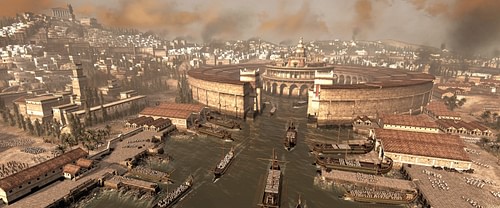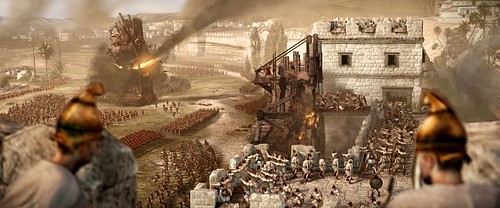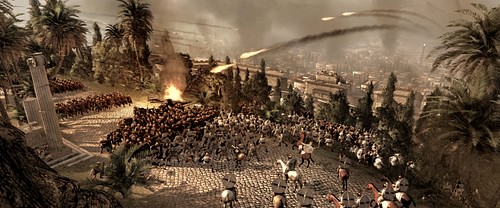what happened to at the end of the 3rd punic war?
The Third Punic War was fought betwixt Carthage and Rome between 149 and 146 BCE. Carthage had already lost ii wars against Rome, but their assault on their Numidian neighbours gave the Romans the perfect excuse to shell this troublesome enemy once and for all. Afterward a lengthy siege, the city was sacked and the Carthaginians were sold into slavery.
As Cato had famously declared in the Roman Senate, 'Carthage must be destroyed'. Consequently, one of the greatest powers in the ancient Mediterranean was wiped off the map forever.
Causes of the War
Carthage had lost the Outset Punic War (264-241 BCE) and control of Sicily, then again it had been defeated in the 2nd Punic War (218-201 BCE) and and then lost its Spanish empire, its fleet, and independence of armed forces activity. In both wars, the Carthaginians had also been made to pay Rome massive reparations. Nevertheless, Carthage recovered from the Second Punic War relatively quickly and coins and trade goods from this period have been establish across the Mediterranean (fifty-fifty in the Balkans) which adjure to the city's prosperity based on trade. Carthage kept on friendly terms with Rome besides, declaring their great general Hannibal - Roman enemy No. ane - an exile when he fled to the court of Antiochus III. The metropolis became an important source of grain and barley for Rome as well; they managed to regularly pay the reparations from the 2d Punic War, and even gave military assistance to Rome's campaigns elsewhere.
As the second century BCE wore on, though, the Carthaginians gradually became more than ambitious in their demands for command of their own destiny. Carthage sorely resented the loss of its territory to Numidia under the rule of Masinissa. The Numidians had been steadily expanding their territorial command and so that ultimately they acquired around half of Carthage's territory as it had stood in 200 BCE. The Carthaginians responded to an attack on Oroscopa by sending an army of 31,000 men to fight the Numidian king in 150 BCE. Carthage's campaign was a disaster and their army was annihilated, just Rome now had the perfect excuse to finally trounce its sometime enemy one time and for all, sack Carthage, and accept some easy war booty. Such figures as Marcus Porcius Cato (Cato the Elder), who had seen for himself Carthage's resurgence during a diplomatic visit in 153 BCE, persistently demanded in the Roman Senate that equally the Carthaginians had waged war without Roman permission, and worse, had washed and then against an ally of Rome, 'Carthage must be destroyed'. The Third Punic State of war was about to begin.
'Carthage must exist destroyed'
Cato the elder to the Roman Senate.
Rome Declares State of war
The Carthaginians sent envoys to Rome to explain their actions and grievances against Masinissa, merely they were rebuffed. Many senators had been pushing for military machine activity against Carthage for the last two or three years, and now seemed the last straw. Then, an of import evolution may have persuaded the more than cautious members of the Senate. Seeing the writing on the wall, Utica, possibly wisely, defected to the Roman cause. A long-time ally of Carthage, the city would provide a good harbour for a Roman invasion forcefulness simply ane 24-hour interval's canvass from Carthage. In 149 BCE the Senate continued a charade of affairs past asking for 300 Carthaginian noble children as hostages but then revealed its true intentions by finally declaring war for a 3rd time on Carthage. An regular army of up to 80,000 infantry and iv,000 cavalry was dispatched to North Africa.
The Romans beginning demanded of Carthage an unconditional surrender under which terms they were to disband their army, manus over all arms, and release all prisoners. On top of that and perhaps indicating Rome'southward intentions to destroy Carthage no matter what happened, the Carthaginians were told to leave Carthage completely and resettle in another place not closer than 16 kilometres to the declension. Carthage, now with nothing much to lose, decided to make a stand. Slaves were released from the city and a Carthaginian army of 30,000 recalled from the Numidian border. The urban center and its population of 200,000 prepared for what would be a three-year siege.

Carthage and its Harbour
Carthage Besieged
The Roman strength was led by the consuls Marcius Censorinus and Manius Manilius simply the first engagements did not go well, and Carthage, with its massive fortifications, resisted the Roman siege on the urban center. Carthage had some 34 kilometres of defensive walls to shelter backside, parts were built in a triple defensive line while other sections were protected by palisades, ditches, and the sea. They resisted everything the Romans could throw at them. More importantly, the Romans were unable to completely occludent the port where merchant vessels still managed to resupply the metropolis. On top of that, the Carthaginians sent out sorties to counter-attack, including fire-ships which set the Roman fleet ablaze. They managed in another raid to destroy some of the Roman siege engines, and then an epidemic hit the besiegers in the long hot summer of 148 BCE.
Meanwhile, the Carthaginian army was remaining a stubborn resistance in the countryside. The city of Hippacra refused to surrender confronting sustained Roman attacks led by the delegate Piso, and even the Numidians, nether a new king Bithyas, sent 800 cavalry to join the Carthaginian land army. The Romans had hoped for a quick and easy capitulation, simply it was commencement to expect like the Third Punic War might grow to the ballsy proportions of the previous wars.
More drastic measures were needed and taken in 147 BCE when the Romans, at present commanded by the young and able consul Publius Cornelius Scipio Aemilianus, congenital a better siege wall around Carthage and its harbour, including a mole on the south side of the city. This latter structure would block the unmarried access to Carthage's mercantile harbour which led in turn to the large circular inner naval harbour. At last, Carthage could no longer be supplied past body of water. In desperation, a modest Carthaginian fleet twice tried to pause the occludent by sailing through a newly made 2nd exit to the harbour just both times they were forced to retreat.

Siege of Carthage
Scipio then systematically attacked the walls about the harbour using the mole as a base. The Carthaginians responded by attacking and burning some of the Roman siege engines, but Scipio persisted and managed to take control of the new archway dug by the Carthaginians. Once more the city was totally cut-off, and Scipio was making the siege seem a whole lot easier than his predecessors had done. The Carthaginian regular army was hemmed in at Nepheris, 25 kilometres south of Carthage, and unable to aid the city. In the wintertime of 147/146 BCE Scipio felt confident enough to leave Carthage choking from his stranglehold and defeated the army at Nepheris after a 3-week siege.
Carthage Destroyed
The final Roman hammer blow came in the spring of 146 BCE when they launched an all-out attack on Carthage. Again, the harbour surface area was selected every bit the bespeak of entry, and this time, the Romans broke through the defences and slowly advanced through the city. After vii days of brutal street-fighting and much time-wasting looting by ill-disciplined legionaries, only the citadel remained to be taken. Here the Carthaginian commander Hasdrubal and 900 desperate Roman deserters held out in the temple of Eshmun. They could expect no mercy, and Hasdrubal'due south torturing of Roman prisoners on the battlements earlier in the battle, even if done to steel the resolve of the Carthaginians, must now accept been regretted. Equally the Roman set on gained ground, Hasdrubal gave himself upwardly but, in shame and outrage, his married woman threw herself and her two children onto the massive funeral pyre onto which the concluding remaining soldiers also committed themselves. Carthage had finally fallen.

Carthage Nether Siege
All of the inhabitants were enslaved and the urban center utterly destroyed (the myth that the land was then spread with salt to prevent resettlement is a afterwards invention). A curse was then set on any person who attempted to resettle the area. Northward Africa was and then fabricated a Roman province while those cities who had been loyal to Rome, such as the new majuscule Utica, were given the privilege of freedom from tax. For his exploits, Scipio became Cornelius Scipio Aemilianus Africanus (known later every bit Scipio Africanus the Younger to distinguish him from his namesake granddad, Scipio Africanus the Elderberry) and was awarded a triumph in Rome.
Carthage would remain uninhabited until the city was re-founded by Julius Caesar and further encouraged by Augustus a century later. As history is written by the victors, the Punic culture was persistently bashed and maligned by generations of Roman writers, but information technology remained remarkably resilient, as did the Punic language, in the countryside and smaller settlements of North Africa long afterward the Punic Wars had robbed information technology of its figurehead city.
This article has been reviewed for accuracy, reliability and adherence to academic standards prior to publication.
Source: https://www.worldhistory.org/Third_Punic_War/
0 Response to "what happened to at the end of the 3rd punic war?"
Publicar un comentario